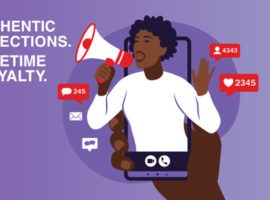Customer engagement strategy 101: Definition and tips
 Does having a customer engagement strategy really matter? Absolutely. Learn how to boost loyalty, drive revenue and build valuable customer relationships.
Does having a customer engagement strategy really matter? Absolutely. Learn how to boost loyalty, drive revenue and build valuable customer relationships.
Between surging inflation, unending supply chain challenges, and staffing shortages everywhere, customer experience is taking a beating.
Indeed, according to Forrester’s annual report on customer experience (CX), the way customers feel about their interactions with companies has dropped significantly over the past year.
Nineteen percent of brands experienced declines in CX scores, with airlines, auto manufacturers, and hotels all seeing lower rankings.
Forrester says much of the falloff can be attributed to macroeconomic factors, but brand marketers must also shoulder some responsibility.
“CX quality in the U.S., which reached new heights in 2021, has fallen to pre-pandemic levels due to brands losing their customer focus,” said Rick Parrish, vice president and research director at Forrester. “This is unfortunate for businesses that survived the worst of the pandemic but are now losing CX-driven customer loyalty gains.”
 Does having a customer engagement strategy really matter? Absolutely. Learn how to boost loyalty, drive revenue and build valuable customer relationships.
Does having a customer engagement strategy really matter? Absolutely. Learn how to boost loyalty, drive revenue and build valuable customer relationships.
According to the American Customer Satisfaction Index, customer satisfaction dropped to its lowest level in 17 years during the first quarter of this year, continuing a downward trend the company says started in 2019.
Case in point: In the travel industry — airlines, hotels, car rentals, and online travel agencies — customer satisfaction is plummeting, ASCI reported.
“Many folks ventured out to travel for the first time since the pandemic hit only to be met with lackluster service and dashed hopes,” said Forrest Morgeson, Assistant Professor of Marketing at Michigan State University and Director of Research Emeritus at the ACSI. “We see this with hotels, where the quality of amenities and food services both dip below customer experience benchmarks of 70.”
The restaurant industry also is suffering from bad CX. Labor shortages have resulted in long wait times for tables and reduced hours of service, according to a CNBC report.
To regain their CX mojo, experts say it will be critical for brands to become more customer obsessed – something most claim to be, but according to Forrester, only 3% of U.S. companies truly accomplish.
Becoming customer obsessed is harder to accomplish than you might think. It’s not just about emphasizing the importance of customer experience in employee communications, press releases, speeches, and financial reports. It’s about regularly engaging with customers, gauging their shifting sentiment and priorities, then delivering products, services, and experiences to meet their needs.
That’s just common sense. But business and marketing leaders, who are human beings after all, often struggle with this because their minds are on other short-term priorities like closing sales and making their numbers at the end of the quarter.
Leaders, nonetheless, need to look beyond such distractions and remember that every business begins and ends with how customers feel about the experiences you provide.
In fact, McKinsey research has shown that improving CX has increased revenues by 2% to 7% and profitability by 1% to 2%. Conversely, 86% of consumers will leave a brand they were once loyal to after two or three bad customer experiences, which can have a negative impact on sales and profitability, a recent Emplifi study finds.
At the same time, 54% of customers who say they felt happy, valued or appreciated are willing to forgive brands that make mistakes, Forrester’s study found.
 Digital-focused KPIs help businesses measure success, but don’t overlook customer engagement and satisfaction in the demand for data.
Digital-focused KPIs help businesses measure success, but don’t overlook customer engagement and satisfaction in the demand for data.
So, how can a business leader become more customer obsessed and turn the tide on bad customer experience? Here are three basics to start with:
Surveys are one useful means of learning what customers think, but aren’t nearly enough. In fact, many customers see them as lazy and detached ways for companies to act like they care about their thoughts or concerns.
That’s why nothing can replace the value picking up a telephone, jumping on a Zoom call, or meeting face-to-face with customers. Unfortunately, CEOs and other leaders spend most of their time in meetings and only about 3% of their working week with customers, according to a Harvard study. Let’s face it: you can’t be customer obsessed if all you do is look at studies, spreadsheets, and sales reports. They tell you nothing about how customers feel about your brand.
The best way to learn how customers feel is to ask them directly. Regular meetings and customer advisory boards are a couple ways to do that. Creating online communities offers another way of staying connected with customers. And making sure human beings respond to customer social media posts, positive and negative alike, can help assure customers that a brand cares about their needs.
 A seamless customer experience is a priority for brands today, with 84% of companies that improve their CX seeing increased revenue.
A seamless customer experience is a priority for brands today, with 84% of companies that improve their CX seeing increased revenue.
It’s one thing to speak to customers and quite another to make them feel heard. Research consistently shows that consumers don’t believe brands listen to them. Brands often ask for input, but customers don’t always believe they’re doing much with it.
Brands demonstrate their listening skills by making meaningful changes (based on customer input) to everything from their business approach to their product mix and their genuine commitments to social causes.
They also do so by eliminating common irritations, such as continuing to send emails after customers opt-out. When customers truly believe that a brand is listening to them, overall CX satisfaction rises and deeper relationships emerge.
W. Edwards Deming says the job of a leader is to transform the organization, especially when it comes to CX. Customer obsession must start at the top. Leaders have to set the example by not only regularly talking to customers and mandating action but communicating how, when, and why they are doing so. They need to make clear there’s no alternative to customer obsession.
They should emphasize that no product should come about just because a product developer or marketer fancies it. As Apple’s Steve Jobs said, “You’ve got to start with the customer experience and work back toward the (product), not the other way around.”
Brands have an opportunity to turn customer perceptions around by delivering the types of experiences customers demand and rightfully deserve. It starts with a commitment to put the effort where the mouth is and act in way that customers appreciate and value.